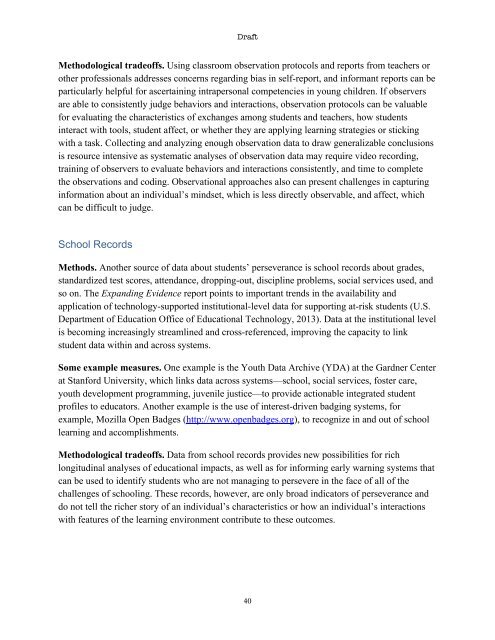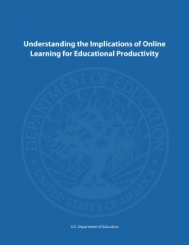Promoting Grit, Tenacity, and Perseverance - U.S. Department of ...
Promoting Grit, Tenacity, and Perseverance - U.S. Department of ...
Promoting Grit, Tenacity, and Perseverance - U.S. Department of ...
You also want an ePaper? Increase the reach of your titles
YUMPU automatically turns print PDFs into web optimized ePapers that Google loves.
Draft<br />
Methodological trade<strong>of</strong>fs. Using classroom observation protocols <strong>and</strong> reports from teachers or<br />
other pr<strong>of</strong>essionals addresses concerns regarding bias in self-report, <strong>and</strong> informant reports can be<br />
particularly helpful for ascertaining intrapersonal competencies in young children. If observers<br />
are able to consistently judge behaviors <strong>and</strong> interactions, observation protocols can be valuable<br />
for evaluating the characteristics <strong>of</strong> exchanges among students <strong>and</strong> teachers, how students<br />
interact with tools, student affect, or whether they are applying learning strategies or sticking<br />
with a task. Collecting <strong>and</strong> analyzing enough observation data to draw generalizable conclusions<br />
is resource intensive as systematic analyses <strong>of</strong> observation data may require video recording,<br />
training <strong>of</strong> observers to evaluate behaviors <strong>and</strong> interactions consistently, <strong>and</strong> time to complete<br />
the observations <strong>and</strong> coding. Observational approaches also can present challenges in capturing<br />
information about an individual’s mindset, which is less directly observable, <strong>and</strong> affect, which<br />
can be difficult to judge.<br />
School Records<br />
Methods. Another source <strong>of</strong> data about students’ perseverance is school records about grades,<br />
st<strong>and</strong>ardized test scores, attendance, dropping-out, discipline problems, social services used, <strong>and</strong><br />
so on. The Exp<strong>and</strong>ing Evidence report points to important trends in the availability <strong>and</strong><br />
application <strong>of</strong> technology-supported institutional-level data for supporting at-risk students (U.S.<br />
<strong>Department</strong> <strong>of</strong> Education Office <strong>of</strong> Educational Technology, 2013). Data at the institutional level<br />
is becoming increasingly streamlined <strong>and</strong> cross-referenced, improving the capacity to link<br />
student data within <strong>and</strong> across systems.<br />
Some example measures. One example is the Youth Data Archive (YDA) at the Gardner Center<br />
at Stanford University, which links data across systems—school, social services, foster care,<br />
youth development programming, juvenile justice—to provide actionable integrated student<br />
pr<strong>of</strong>iles to educators. Another example is the use <strong>of</strong> interest-driven badging systems, for<br />
example, Mozilla Open Badges (http://www.openbadges.org), to recognize in <strong>and</strong> out <strong>of</strong> school<br />
learning <strong>and</strong> accomplishments.<br />
Methodological trade<strong>of</strong>fs. Data from school records provides new possibilities for rich<br />
longitudinal analyses <strong>of</strong> educational impacts, as well as for informing early warning systems that<br />
can be used to identify students who are not managing to persevere in the face <strong>of</strong> all <strong>of</strong> the<br />
challenges <strong>of</strong> schooling. These records, however, are only broad indicators <strong>of</strong> perseverance <strong>and</strong><br />
do not tell the richer story <strong>of</strong> an individual’s characteristics or how an individual’s interactions<br />
with features <strong>of</strong> the learning environment contribute to these outcomes.<br />
40
















